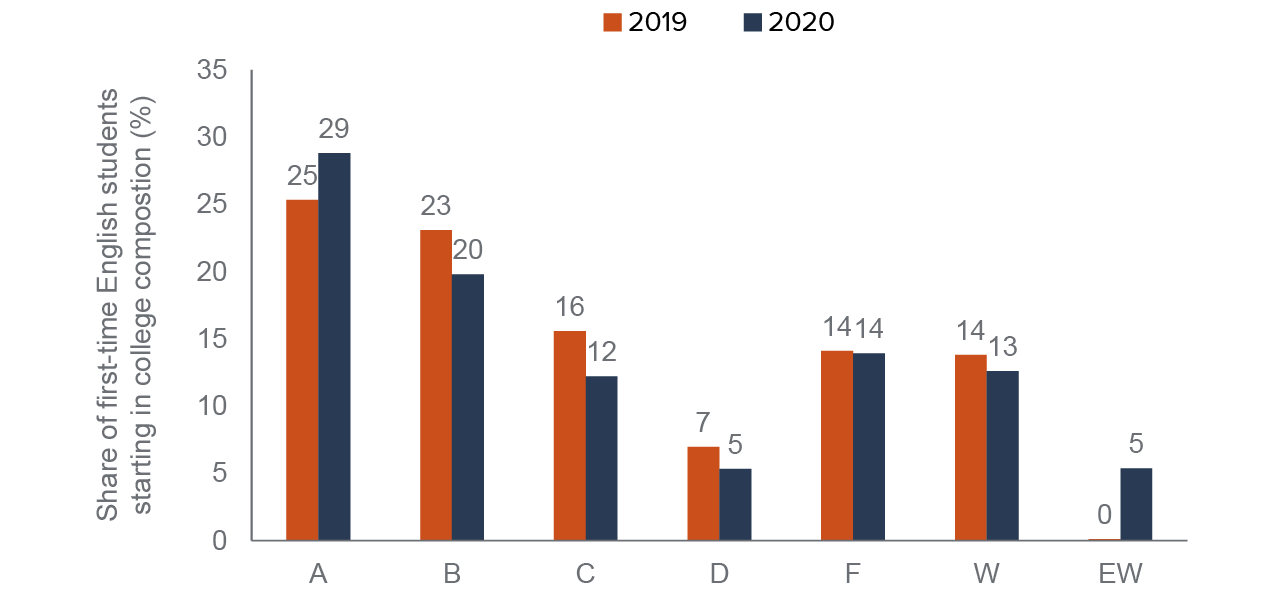Table of Contents
- Key Takeaways
- Introduction
- AB 705 Implementation Has Substantially Improved Student Outcomes
- AB 705 Implementation during the First Year of the Pandemic
- Corequisite Remediation Is a Work in Progress
- Learning More about Students Who Did Not Succeed during the First Term of Implementation
- Student Success beyond College Composition
- Reducing Racial and Ethnic Gaps in Student Success
- Conclusion
- Glossary of Terms
- Notes and References
- Authors and Acknowledgments
- PPIC Board of Directors
- Copyright
Key Takeaways
California’s community colleges began implementing Assembly Bill 705 (AB 705) in fall 2019, making major assessment and placement reforms that moved students away from remedial prerequisites for English and math and into transfer-level courses. Building on our previous research, this report examines the progress colleges and students have made in shifting toward transfer-level English courses through fall 2020; we also look at the impact of the pandemic and the shift to online learning on AB 705 implementation.
- Colleges continued to implement AB 705 in the face of COVID-19. Despite a significant decline in enrollment in fall 2020, access to gateway transfer-level English remained high, continuing the progress made in the previous fall. In fact, the share of students enrolling directly in college composition actually increased slightly (from 95% to 97%), and the share of first-time English students completing these courses only declined slightly (from 61% to 59%). →
- Colleges are still figuring out the best ways to provide corequisite remediation to their students. In the first year of the pandemic, a slightly lower share of students started in college composition along with corequisite support; among those who did, the rate of successful completion declined (from 58% to 53%). Some colleges found it challenging to shift corequisite courses from face-to-face to online settings—indeed, a handful stopped offering corequisites altogether. →
- More research is needed to better understand the barriers and challenges facing students who have not been successful under the new system and identify effective interventions. Only 40 percent of the 56,600 students who started in college composition in fall 2019 and did not successfully complete it had re-enrolled as of fall 2020. More than half of the students who did not re-enroll did not return to the system at all. In all, only 16 percent of initially unsuccessful students successfully completed college composition by fall 2020. →
- Our findings indicate that despite faculty concerns, broader access to gateway courses under AB 705 does not appear to leave students underprepared to succeed in subsequent transfer-level courses. An analysis of successful completion of critical thinking courses in early implementer colleges suggests that students are performing just as well as previous cohorts. →
- Colleges must prioritize equitable student success now that nearly all first-time English students are enrolling in transfer-level coursework. While racial/ethnic gaps in access to college composition are mostly closed, completion rates remain significantly lower among Black and Latino students. Our interviews with faculty indicate that reforms to pedagogy, instructional practices, and grading as well as expanded equity-centered support for both students and instructors are key, especially in light of the pandemic. →
Introduction
Starting in fall 2019, Assembly Bill 705 (AB 705) transformed the way California community colleges place and remediate their students. This law has dramatically reduced the number of students placed in remedial English and math courses, which had constituted a major barrier to the achievement of academic goals and driven profound racial inequities in access to transfer-level courses (Cuellar Mejia, Rodriguez and Johnson 2016; MDRC 2013).
Almost three years later, interest in AB 705 remains strong. Heated debates continue about what it means to implement the law “with fidelity,” whether corequisite courses (curricular models in which students receive additional support while enrolled in the transfer-level course) are effective, and whether remedial courses should remain an option (Hern, Snell, and Henson 2020; Hern and Snell 2021; Schlueter 2022; Hern 2022).
This report is the second in a two-part series. Last December we released a report on the effect of AB 705 on completion of gateway math courses as of fall 2020. We found that, as colleges continued to implement AB 705 in the face of the COVID-19 pandemic, rates of direct enrollment in transfer-level math courses held steady while the rate of successful completion of those courses increased. However, we also found that a substantial number of students were still required or allowed to enroll in below-transfer-level (BTL) courses. This is especially troubling because when access to transfer-level math courses is restricted or discouraged, Black and Latino students are more likely to end up in BTL courses, and are therefore less likely to complete transfer-level courses.
This report focuses on the effect of AB 705 on the outcomes of students taking English courses for the first time (referred to as first-time English students or first-time English takers in the rest of this report). Our earlier work showed that in fall 2019, the first term of statewide implementation, colleges were significantly further along in compliance with AB 705 in English than in math, as evidenced by almost universal access to college composition.
The effect of AB 705 on student outcomes beyond initial transfer-level courses has been a concern. Some faculty argue that despite the important increases in the share of students successfully completing the gateway transfer-level courses on the first try, students are less prepared to succeed in subsequent courses. This research speaks to those concerns. Our research can also contribute to the ongoing discussion of additional legislation that aims to clarify and strengthen the intent of AB 705, close loopholes that impede implementation, and provide additional guidance to ensure all students benefit from these successful reforms. Finally, our study is well positioned to make significant contributions to the national conversation on remedial education reform. Other states are looking to California for evidence on the effectiveness of state-level legislation.
We rely on longitudinal student-level data provided by the California Community Colleges Chancellor’s Office (which covers the universe of students enrolled across all 115 colleges in the system) to shed light on progress toward equitable completion of college composition as of fall 2020. First, we summarize the impact of AB 705 implementation on access to and completion of college composition, including its effect on racial equity. Next, we examine how AB 705-related outcomes changed during the first year of the pandemic. We also look at changes in corequisite offerings and outcomes in relation to the pandemic. Then, we take a closer look at students who were not successful in college composition in the first term of systemwide implementation and their outcomes as of the following fall. Next, we address concerns about broader access to college composition leaving students less prepared to succeed in subsequent courses by examining the effect of AB 705 on successful completion of critical thinking—the second transfer-level course required for a degree or transfer. We then discuss some of the ways in which colleges have reformed their pedagogy and classroom practices, and expanded their support for students and instructors in order to narrow racial equity gaps. We conclude with recommendations derived from our research.
As part of this research, we conducted 41 semi-structured interviews with community college department chairs, faculty, staff, and administrators at 22 colleges with varying scales of AB 705 implementation and rates of access and success. Our main goal was to learn more about how colleges are addressing racial equity gaps and the challenges they are facing. Given that by the time the interviews were conducted colleges had been in a post-COVID environment for over a year, we also asked about lessons learned from the pandemic. Text boxes with interview highlights appear throughout the report to contextualize and explain our quantitative findings. For more information about our interviews, see Technical Appendix C.
The pandemic disrupted student enrollment, housing, and finances, changing the college experience in significant and meaningful ways. Although this reality limits our ability to interpret changes beyond fall 2019, it allows us to report on how different institutions and students groups are faring under our new reality.
AB 705 Implementation Has Substantially Improved Student Outcomes
AB 705 implementation has dramatically improved the chances of students completing college composition. Latino and Black students, who were most likely to be placed in remediation, have benefited greatly. However, racial equity gaps remain. In this section, we summarize the changes brought out by the implementation of AB 705. As we will see in the rest of the report, the work is not over, but it is important to bear in mind how far the system has come (Figure 1).
Access to college composition is nearly universal. After AB 705 implementation, 96 percent of students who took an English course for the first time enrolled in college composition. This is a dramatic change from fall 2015, when only 38 percent of first-time English students enrolled in college composition.
Racial/ethnic gaps in access to college composition have mostly disappeared. One of the most notable effects of AB 705 has been the dramatic improvement in equitable access to college composition. Indeed, access gaps between racial/ethnic groups (differences in the shares of first-time English students enrolling directly in college composition) were virtually eliminated. The gap between white and Latino students decreased from 25 percentage points to 1 percentage point. Similarly, the gap between white and African American students dropped from 31 percentage points to 3 percentage points.
Increased access has allowed many more students to complete college composition. In 2019 and 2020, 60 percent of first-time English students (158,000 in fall 2019 and 138,000 in fall 2020) successfully completed college composition in one term, compared to only 27 percent (or 61,000) of first-time English takers in 2015.
College composition completion has improved significantly among all racial/ethnic groups, although equity gaps persist. All racial/ethnic groups have seen increases above 30 percentage points since AB 705 implementation. For example, successful completion rates among Black first-time English students increased from 15 percent to 47 percent and among Latino first-time English students from 20 percent to 55 percent. However, completion rates continue to be significantly lower among Black and Latino students: a 22 percentage point gap between Black students and white students; and a 14 percentage point gap between Latino students and white students.
The implementation of AB 705 dramatically improved outcomes for first-time English students
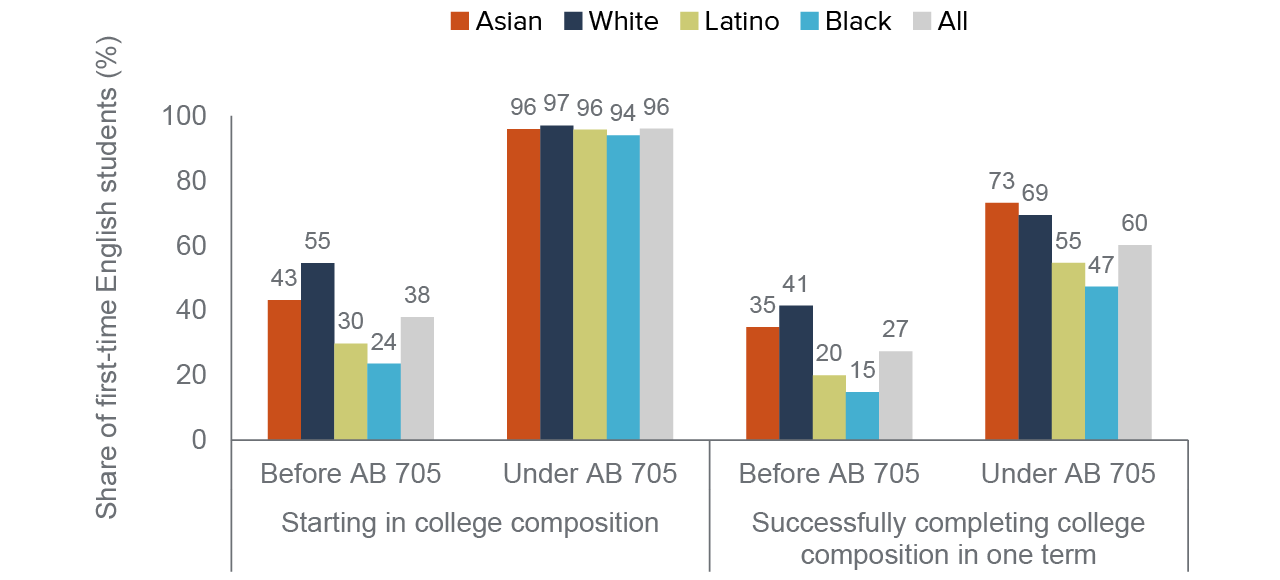
SOURCE: Authors’ calculations using MIS data.
NOTE: “Before AB 705” = 2015. We use fall 2015 as a baseline year because early implementation of changes aimed at broadening access to transfer-level courses started in 2016. “Under AB 705” = the weighted average of outcomes for the fall 2019 and fall 2020 cohorts combined.
Students who start in transfer-level courses with corequisites are more likely to complete them than students who start in remedial courses. Only 27 percent of students who start in a remedial English course successfully complete college composition in one year (and 32% as of the following fall). On average, students in corequisites are about 30 percentage points more likely to complete college composition in one term than students who start in remedial education are to complete it in one year (Figure 2). However, it’s not clear that all students who could benefit from corequisite support are getting it: fewer than one in five first-time students enrolled in these courses in 2019 and 2020.
Corequisite students are more much likely to complete college composition than remedial students
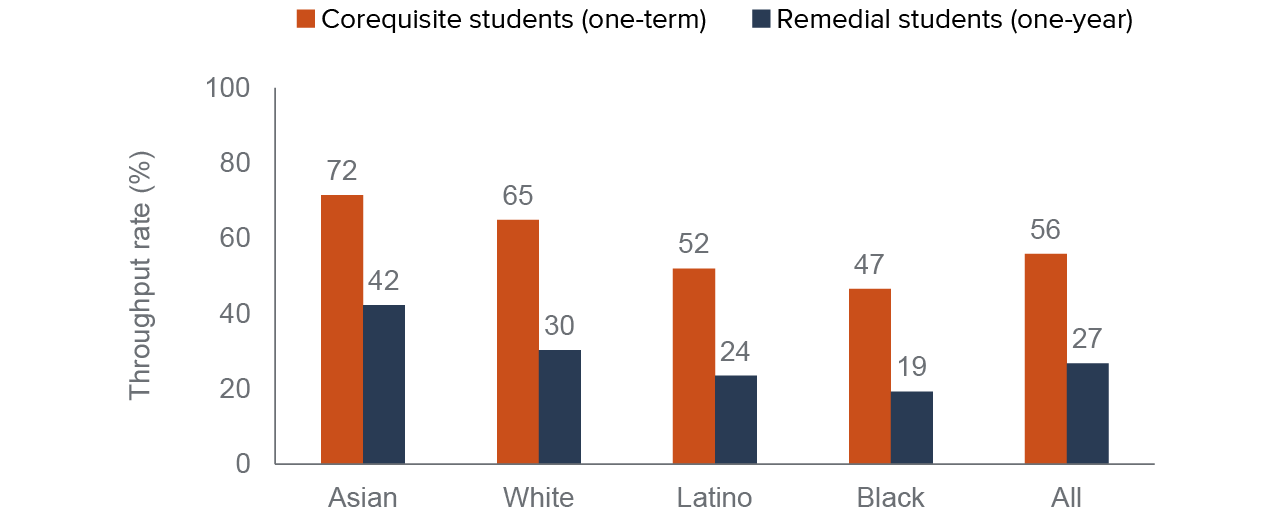
SOURCE: Authors’ calculations using MIS data.
NOTES: One-year throughput rate among remedial students who started in fall 2019. One-term throughput rate among corequisite students (weighted average fall 2019 and fall 2020 cohorts). For reference, there were 7,794 remedial students and 58,388 corequisite students (32,739 in the fall 2019 cohort and 26,070 in the fall 2020 cohort).
AB 705 Implementation during the First Year of the Pandemic
The COVID-19 pandemic hit during the second academic term of AB 705 implementation, affecting one-year outcomes for the fall 2019 cohort and outcomes for a new cohort of first-time English students in fall 2020. In this section, we compare outcomes for students who took their first English course in fall 2020, during the pandemic, to those who did so in fall 2019, pre-pandemic. While our focus is on comparing fall 2019 and 2020 cohorts, most figures in this section also cover earlier cohorts, so that we have some sense of changes brought on by the pandemic.
The Number of First-Time English Students Decreased
Consistent with the pandemic-induced decline in overall community college enrollment, the number of first-time students intending to get an associate degree or transfer to a four-year university—the pool of students most likely to take an English/math course at some point—declined 18 percent between fall 2019 and fall 2020. Meanwhile, the number of first-time English students decreased by 14 percent.
However, the decline in the English cohort was higher than the decline in the math cohort (9%). We identified two possible reasons for this. First, because degree/transfer-intending entering students are more likely to take English than math in their first term in college (58% versus 44%, Technical Appendix Figure B1), an overall decline in first-time students is more likely to affect English course enrollment. Second, the decline in the number of first-time math students was cushioned by a much smaller decline among continuing students than among first-time-in-college students (3% versus 16%). By contrast, among first-time English students, both first-time-in-college and continuing students registered declines of 14 percent.
It is important to note that there was no reduction in the size of the English cohort during the statewide implementation of AB 705 in fall 2019 (Figure 3). This stands in contrast to the decline observed in the size of the cohort of first-time math students. Students delaying math enrollment was a major driver of the 11 percent decline between fall 2018 and fall 2019. Relative to our baseline year, 2015, in 2020 the number of first-time English students was down 12 percent, while the number of first-time math students was down 22 percent.
In 2020, first-time English takers declined more sharply than first-time math takers
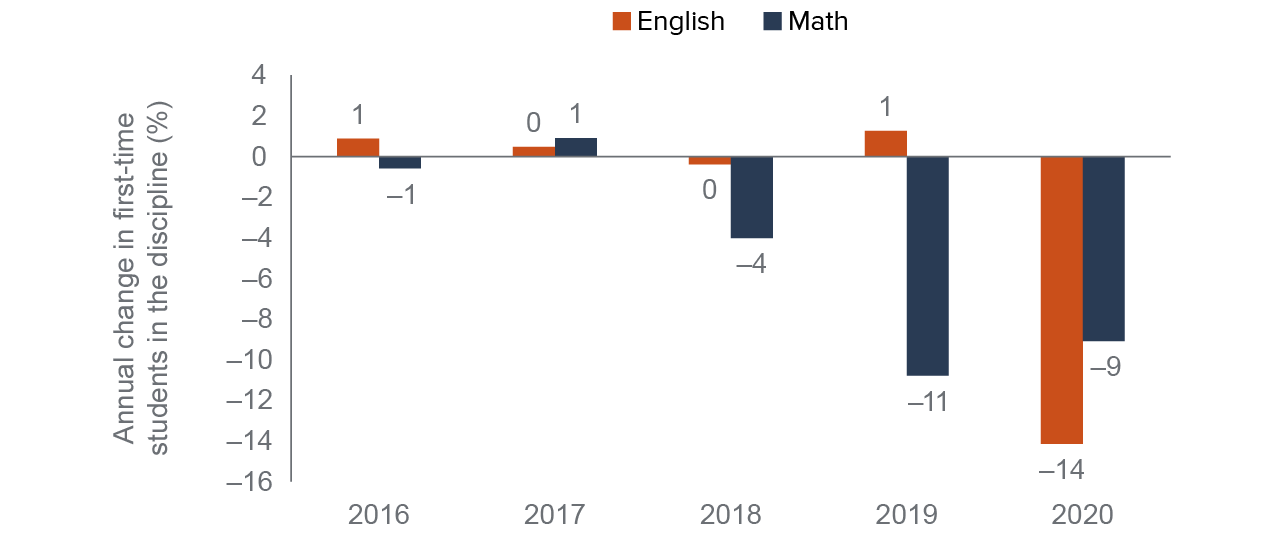
SOURCE: Authors’ calculations using MIS data.
NOTE: Fall-to-fall annual change. For reference, there were 141,976 first-time English students and 128,471 first-time math students in fall 2020.
The decline in the number of first-time English takers was widespread, although the declines varied significantly across the system (Technical Appendix Table B1). In fact, 106 of the 115 colleges in the system experienced declines. In 22 colleges, the declines were substantial—ranging from 28 percent to 66 percent, which is two times or more the systemwide decline of 14 percent. In 23 colleges, the declines were much smaller, ranging from 1 percent to 7 percent (half the systemwide rate). Colleges with smaller cohorts of first-time students were more likely to experience the largest declines. At a regional level, colleges in the East Central, Los Angeles, and Desert regions had the largest declines in the number of first-time English takers, while the lowest declines were in the San Diego/Imperial and Northwest regions (Technical Appendix Figure B2).
At six of the seven colleges with increases in their number of first-time English takers—Canyons, Crafton Hills, De Anza, Lassen, Folsom Lake, and Solano—increases in the shares of first-time students taking college composition in their first term were higher than average, which helped to offset the decline in the number of degree/transfer-intending students (Technical Appendix Figure B3 and Table B2). Increases in the number of continuing students taking English for the first time also contributed to increases in the number of first-time English students at these colleges.
A key consideration is whether the decline in the number of first-time English students was more acute among some student groups than others. A disproportionate number of Latino and Black students bore the brunt of these declines, consistent with the pandemic’s broader economic and health consequences for Blacks and Latinos (Hardy and Logan 2020; Zamarripa and Roque 2021). While there were only 2 percent fewer white first-time English students in fall 2020 than in fall 2019, there were 20 percent fewer Black students, 17 percent fewer Latino students, and 15 percent fewer Asian students. As a result, between fall 2019 and fall 2020, white students gained representation among first-time English students (from 19% to 21%), while the share of Latino students decreased 2 percentage points (from 55% to 53%). Participation remained unchanged for both Black and Asian students (Technical Appendix Table B3).
Direct Access to College Composition Increased Slightly
Despite these disruptions, near-universal access to college composition continued during the pandemic. The share of first-time English students starting in college composition increased from 95 percent in 2019 to 97 percent in 2020 (Figure 4). Remarkably, in 106 of the 115 colleges in the system, at least 90 percent of students started in college composition, and in 41 of those not a single student started in remediation (See Technical Appendix Table B4). Access rates at the remaining 8 colleges ranged from 65 percent to 89 percent.
We find that between fall 2019 and fall 2020 only 15 of the 115 colleges saw declines—from 9 to 1 percentage points—in the share of students starting in college composition. In comparison, 40 colleges saw 18 to 1 percentage point declines in access rates to transfer-level math.
Near-universal access to college composition continued despite pandemic disruptions
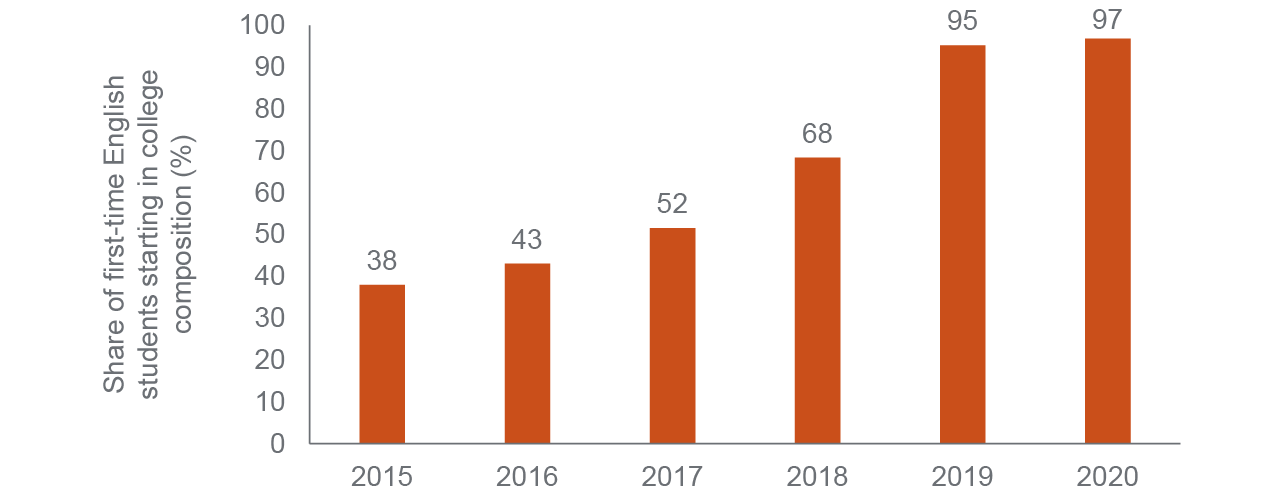
SOURCE: Authors’ calculations using MIS data.
NOTE: Fall cohorts.
In all, only 3 percent of first-time English students (or 4,431) started in a remedial course in fall 2020, 43 percent fewer than in the fall 2019 cohort (Technical Appendix Table B4). Our analysis showed that students with goals other than transfer, continuing students, students with disabilities, non-traditional-age students, and Black students were overrepresented in this group of students.
Successful Completion Rates Changed Slightly
Altogether, 59 percent of first-time English students successfully completed college composition in one term in fall 2020, 2 percentage points below the rate for the fall 2019 cohort. Across racial/ethnic groups, shares of first-time English students successfully completing college composition in one term (i.e., one-term throughput rates) changed slightly between 2019 and 2020. One-term throughput rates declined 3 percentage points among Latino and white students, stayed the same among Black students, and increased 1 percentage point among Asian students (Figure 5).
Successful completions among first-time English students did not change that much during the pandemic

SOURCE: Authors’ calculations using MIS data.
NOTE: Fall cohorts.
Changes in racial equity
Our previous research shows that despite improvements under AB 705, Black students continued to be significantly underrepresented in the group of students successfully completing college composition in fall 2019—they represented 5 percent of all first-time English students but only 3.9 percent of successful completers.
Even though systemwide representation of Black students (as measured by the proportionality index) improved only slightly in fall 2020 (from 0.78 to 0.80), 23 colleges experienced important gains (Technical Appendix Table B5). Importantly, at 9 of these colleges—Berkeley City, Coastline, Contra Costa, East LA, Foothill, LA Valley, Long Beach City, Solano, and Southwest LA—one-term throughput rates for Black students increased more than 10 percentage points.
Latinos are more equitably represented among students completing college composition than Blacks, with a proportionality index of 0.90 in fall 2020. Latino students saw increases in representation similar to the ones observed for Black students at seven colleges, and only three of those colleges (Coastline, Gavilan, and Merritt) saw one-term throughput rates for Latino students increase more than 10 percentage points.
Variation across colleges in one-term throughput rates
Even though systemwide one-term throughput rates declined slightly, there was important variation at the college level. Between fall 2019 and fall 2020, 34 colleges saw increases in throughput rates; at 17 of those colleges, the increases were at least 5 percentage points. Moreover, nine of the colleges with increases of 5 percentage points or more—Foothill, Cañada, San Mateo, Lake Tahoe, Mission, West Valley, LA Valley, Merritt, and Orange Coast—ended up with throughput rates over 65 percent, above the state average of 59 percent (Technical Appendix Table B6). At the other end of the spectrum, 37 colleges experienced declines between 5 and 22 percentage points.
Increased access was an important driver of the increases in throughput rates. The share of students starting in college composition increased 4 percentage points on average in the group of colleges that saw increases in throughput rates, while it remained unchanged in the rest of the system. Changes in throughput rates may have also been linked to changes in classroom practices and colleges’ efforts to ameliorate the pandemic’s impact on student outcomes. It is also possible that the increases in throughput rates in these 34 colleges were driven by the type of students who ended up taking their first English course during the pandemic (i.e., students more likely to succeed were also the ones more likely to enroll during the pandemic).
Grade distribution
During the March 2020 transition to online learning due to the COVID-19 pandemic, the Chancellor’s Office enacted policy changes to ensure that students were not penalized academically or financially for withdrawing from classes due to COVID-19. Students were allowed to use an “excused withdrawal” at any time if they could not continue because of the pandemic without affecting their academic progress, academic probation, or ability to repeat a course.
When we compare the letter grade distribution of first-time English students in fall 2019 and fall 2020 (Figure 6), we see a higher share of students getting As, lower shares getting Bs, Cs, and Ds, and almost identical shares of students getting Fs and withdrawing from courses. The overall decline in successful completions indicates that some would-be completers ended up using excused withdrawal.
It is important to note that first-time English students in the fall 2020 cohort struggled with more than just their English courses. On average, first-time English students in fall 2020 were more likely to struggle academically during that term than first-time English students in fall 2019. Using GPAs in the first term taking a course in the discipline (excluding that course) as a proxy of academic standing, we see that the average GPA (excluding English courses) was 0.39 points lower for the fall 2020 cohort than for the 2019 cohort (2.59 versus 2.98).
One-year and fall-to-fall throughput rates
The COVID-19 pandemic also affected outcomes for the fall 2019 cohort. This was mainly attributable to a decline in persistence into the spring and fall terms among students who were not successful on their first attempt or who started in a BTL course. Indeed, while 45 percent of first-time students in fall 2018 who started in college composition but did not succeed in their first attempt tried again as of the following fall, 40 percent did so in the fall 2019 cohort. Meanwhile, 55 percent of those who started in a remedial course in fall 2018 made it to college composition, compared to 50 percent of those who started in a remedial course in fall 2019.
Despite these decreases, the one-year and the fall-to-fall throughput rates for the 2019 cohort were higher than rates among the 2018 cohort, mostly due to the big increase in one-term completion (Figure 7).
Two-thirds of first-time English students in fall 2019 completed college composition in one year
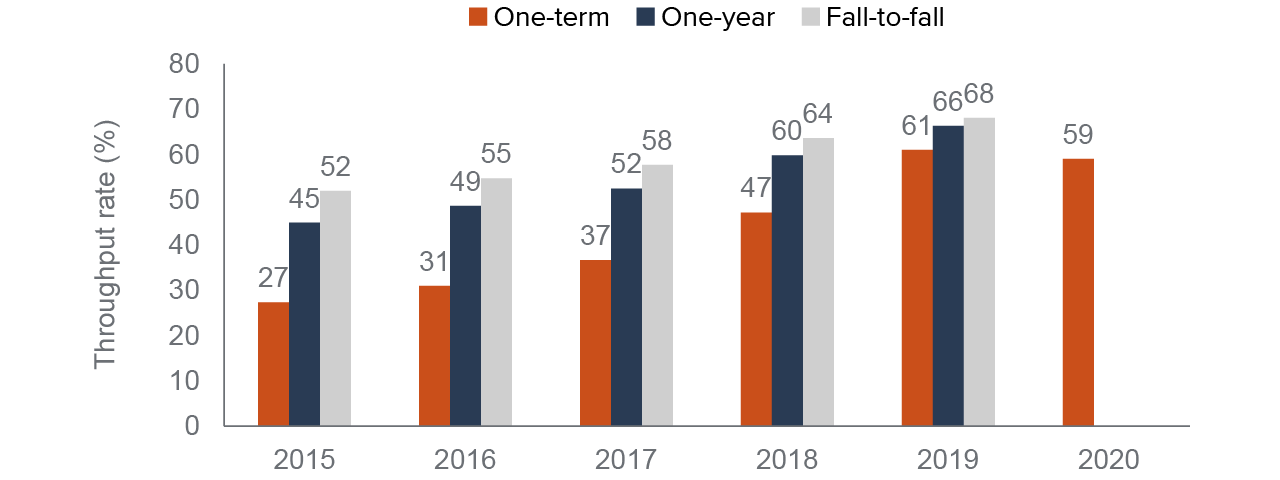
SOURCE: Authors’ calculations using MIS data.
NOTE: Fall cohorts.
Completion Rates at Colleges with a Greater Pre-pandemic Online Presence Did Not Differ Significantly from Rates at Other Colleges
Given the systemwide shift to remote instruction that resulted from the COVID-19 pandemic, an interesting question is whether colleges with a higher proportion of online college composition sections prior to the pandemic had better college composition completion rates in fall 2020 (in fall 2020, instruction remained almost exclusively online in all community colleges). The rationale is that experience in the online setting may have helped faculty make a smoother transition from a few sections to all sections online.
Pre-pandemic, 14 percent of all college composition sections were offered online. There was some variation across colleges, with 16 offering at least a quarter of their sections online. Coastline College offered 72 percent of its sections online, followed by Taft (48%), West LA (45%), Barstow (43%), Siskiyous (38%), and LA Trade-Tech (33%). At the other extreme, 12 colleges offered no more than 5 percent of their sections online.
There does not appear to be a strong relationship between changes in student successful completion rates between fall 2019 and fall 2020 and the prevalence of online learning pre-pandemic—as measured by the share of sections of the course offered online (Technical Appendix Figure B5 and Table B7). Even if the transition to online instruction was smoother in those colleges, students might have still struggled with online learning due to technology constraints, challenges with reliable internet service, lack of access to a quiet study space, or difficulty adjusting to remote instruction. Furthermore, students may have also faced other challenges, including loss of income due to job losses, caregiving commitments, and mental health issues.
Corequisite Remediation Is a Work in Progress
Corequisite support is key to maximizing the impact of AB 705. When implemented effectively, corequisites promote equitable student success by providing time and space for personalized instruction and just-in-time remediation while students are taking college composition. Have corequisites been working as intended? Our analysis suggests that there are challenges—some of which are attributable to the pandemic.
In fall 2020, 26,070 students, or 18 percent of first-time English students, enrolled in a corequisite model. This systemwide average masks great variation: in 12 colleges, more than a third of students enrolled in corequisite courses, while at 10 colleges only 15 percent or less did so and 17 colleges did not offer corequisites (Technical Appendix Table B8).
A Lower Share of Students Started in a Corequisite Model
Between fall 2019 and fall 2020, the decline in the number of first-time English students starting in corequisite models (20%) was greater than the decline among students who took college composition without support (11%) and the overall decline in the number of first-time English students (14%). Consequently, there was a slight decline in the share of students starting in corequisites. The decline was slightly more pronounced among Black and Latino students (2 percentage points), who are more likely to take corequisites. In fall 2020, 23 percent and 20 percent of Black and Latino first-time English students started in corequisite courses, compared to 16 percent and 14 percent of Asian and white students (Technical Appendix Figure B9).
We cannot definitively attribute this decline to students being more reluctant to commit to the extra time/units during the pandemic, academically stronger students enrolling in 2020, colleges being better at identifying students who would benefit the most from the extra support, or reductions in corequisite offerings. It is probably due to a combination of these factors. We do have some indication of reductions in corequisite offerings: four colleges stopped offering corequisite courses altogether in fall 2020. We also heard in our interviews that some colleges found it very challenging to effectively switch their corequisite courses from face-to-face to the online setting.
The share of first-time English students starting in corequisite courses declined in 52 colleges, increased in 37 colleges in fall 2020 and remained the same in 8 colleges (Technical Appendix Table B8).
Success Rates in Corequisite Courses Declined
Not only did fewer students take corequisite support courses, but a lower number of those who did enroll were successful in such courses—there were 28 percent fewer corequisite students successfully completing college composition in fall 2020 than in fall 2019. This meant that while 58 percent of first-time English students in corequisite courses successfully completed in one-term in fall 2019, 53 percent did so in fall 2020. This systemwide figure hides wide variation across colleges, with rates of successful completion ranging from 17 percent to 79 percent (Appendix Table B10).
As we see in Figure 8, declines in one-term throughput rates were more pronounced among corequisite students than non-support students for all racial/ethnic groups. Consequently, the gap in completion rates between corequisite students and students without support widened. For example, in the case of Black students the difference in one-term throughput rates for colleges composition students without and with corequisite support was 3 percentage points in fall 2019 (52% versus 49%) and the gap increased to 7 percentage points in fall 2020 (51% versus 44%).
Declines in one-term throughout rates were more pronounced among corequisite students across racial/ethnic groups
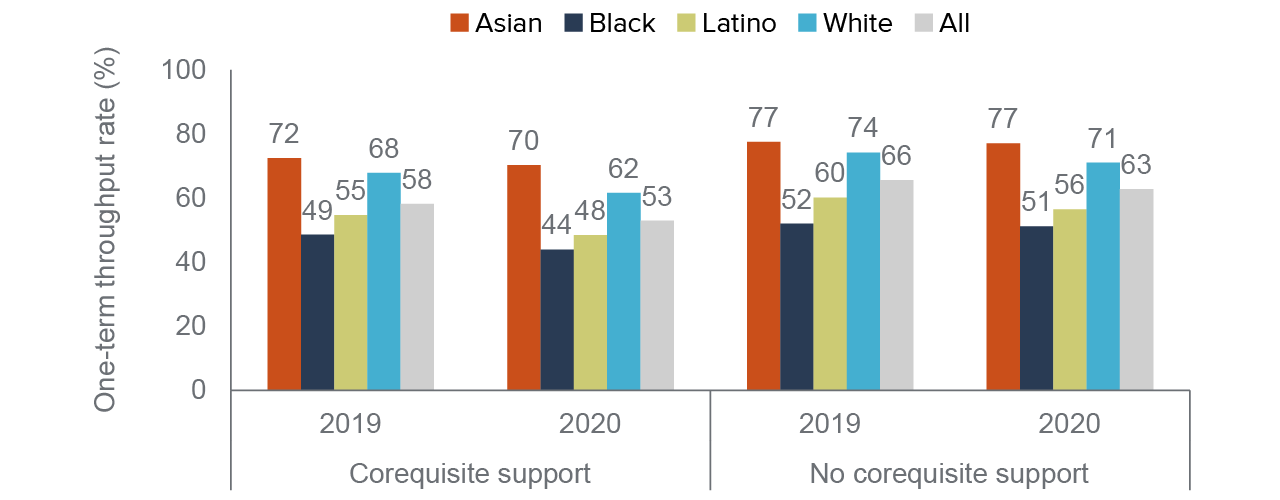
SOURCE: Authors’ calculations using MIS data.
NOTE: Fall cohorts.
Also, corequisite students were more likely to use an excused withdrawal than students who took college composition without support (Appendix Table B11). This is especially true among Latino students: 9 percent of Latino students in corequisite courses used excused withdrawal, compared to 6 percent of Latino students in college composition without support.
Colleges Are Still Figuring out How Best to Provide Academic Support
In fall 2020, five colleges (Cerritos, Cypress, Diablo Valley, Golden West, and LA Harbor) switched from linked corequisites—one- to three-unit linked support courses taken alongside the transfer-level course—to enhanced courses. Citrus College made the same move in fall 2019. In our interviews, we heard that colleges see enhanced courses as a way to eliminate the challenges of enrolling in two separate courses. Altogether, 21 colleges offered enhanced courses in fall 2020 enrolling 5,513 first-time English students or 21 percent of students in corequisite models.
On average, one-term throughput rates were slightly lower among students in enhanced courses relative to students who took college composition with corequisite support (51% versus 54%, Technical Appendix Table B12). Interestingly we did not find evidence that one-term throughput rates for linked corequisites and enhanced courses were statistically different once we control for student demographics and other factors. However, there is wide variation in course design features and the type of students enrolled in both types of courses that we are unable to account for, and which could be biasing our estimates.
One college (Foothill) switched its corequisite course from credit to non-credit in 2020, joining six colleges. The typical linked course offered in fall 2020 added two units to a student’s load. A question that remains in the field is whether the number of corequisite support units has an effect on student success. We did not find evidence that this is the case—the number of units of linked corequisite support is not statistically significant in explaining one-term throughput rates. But, again, in order to accurately measure this relationship, we need more detailed information about academic preparedness of the students who end up in these courses and corequisite design features.
Learning More about Students Who Did Not Succeed during the First Term of Implementation
AB 705 opened the door to transfer-level courses for thousands of additional students. However, about four in ten students (almost 57,000) who started in a college composition course in fall 2019 did not successfully complete it on their first attempt. It is important to learn more about these students and their trajectories so that colleges can identify effective ways to support them.
Who Was Unsuccessful?
Relative to their share of the total cohort of first-time English students, Latino and Black students, part-time students, students with disabilities, and students who stated a goal other than transfer are overrepresented among those who started in a college composition course and did not successfully complete it on their first attempt (Technical Appendix Table B14). By “overrepresented” we mean that the shares of these groups among unsuccessful students is larger than their shares among all students who started in college composition (Figure 9).
Latino and Black students are overrepresented among students who were unsuccessful on their first attempt
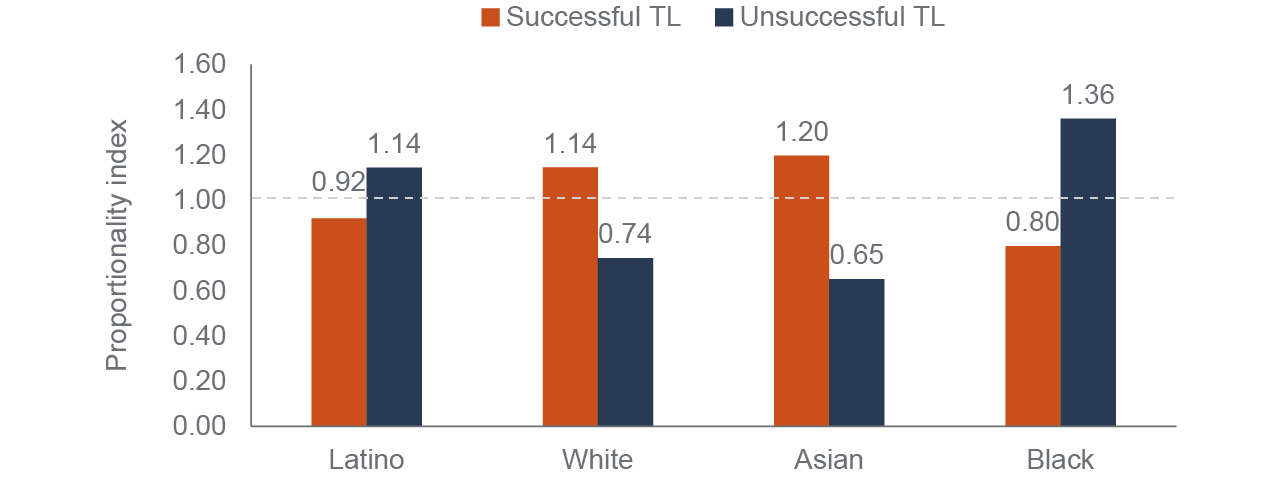
SOURCE: Authors’ calculations using MIS data.
NOTES: TL stands for transfer-level English, which in this case is college composition. The proportionality index (PI) indicates whether a subgroup of students is represented equitably among those successfully completing college composition in one term relative to its representation among all first-time English students who started at transfer-level. A score of 1 in the PI indicates equitable representation.
Many students who were not successful in their first attempt at college composition were struggling with more than just writing and reading. As Figure 10 shows, these students earned a lower proportion of the units they enrolled in than successful students (43% versus 86%) and had a lower GPA, excluding college composition, (2.1 versus 3.5), on average. They were also less likely to be enrolled full time (66% versus 78%).
Students who were unsuccessful on their first attempt were struggling with more than with English
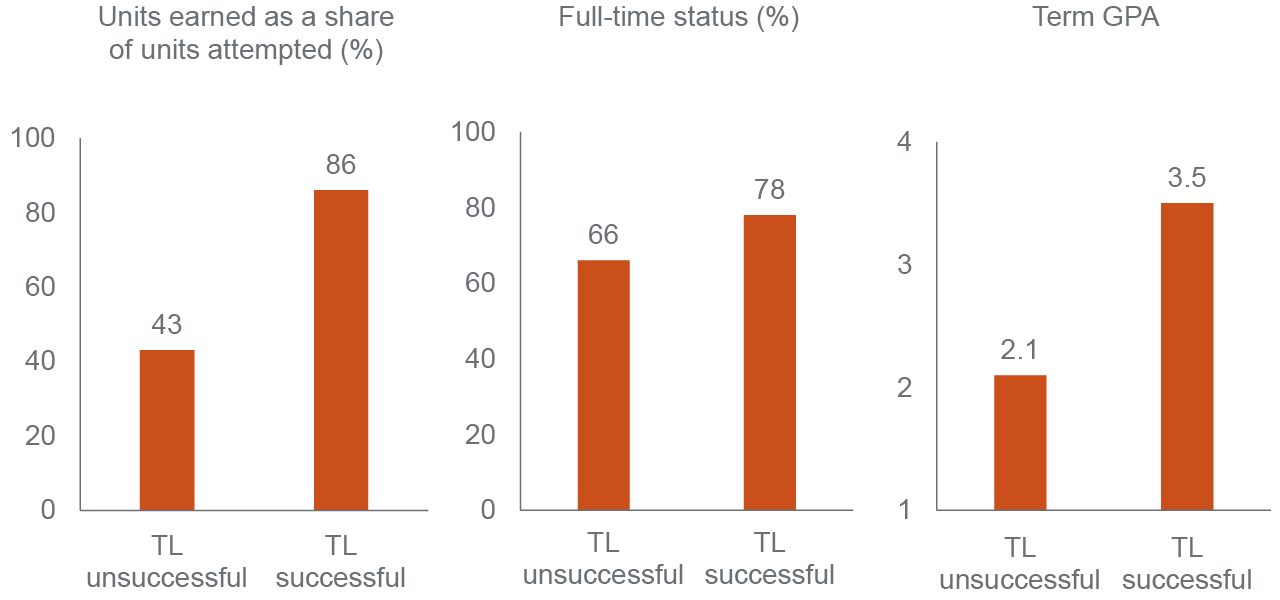
SOURCE: Authors’ calculations using MIS data.
NOTE: TL stands for transfer-level English, which in this case is college composition. Both units earned as a share of units attempted and term GPA exclude English courses.
Fewer than One in Three Unsuccessful Students Re-enrolled in College Composition
Of the 56,635 students who started in college composition in fall 2019 and did not successfully complete it in their first attempt, only 31 percent re-enrolled in the following spring, and 9 percent did so in the following fall. Unfortunately, this was a generalized finding across colleges. There were a few exceptions: at eight colleges—Hartnell, West Valley, Ohlone, LA Pierce, Glendale, Cerritos, Gavilan, and Cypress—half or more students who were unsuccessful in fall 2019 had re-enrolled as of fall 2020 (Technical Appendix B15).
Moreover, students who took the course with corequisite support were less likely to re-enroll than those without support (35% versus 42%). This does not necessarily come as a surprise, considering that at many colleges, students with lower high school GPAs are required or advised to enroll in corequisite courses, and lower prior academic preparation is associated with a higher likelihood of dropping out.
This raises another question: What happened with the 33,764 students in the fall 2019 cohort who did not re-enroll in college composition? More than half (17,613 students) did not return to the system at all in either spring or fall 2020. Given the effect of the pandemic on community college enrollment, it is not surprising that this share is larger than in the fall 2017 and 2018 cohorts (Figure 11). Among the students who did not re-enroll in college composition, 23 percent were still enrolled in the system in fall 2020, but only 27 percent were full-time students.
Over half of unsuccessful students who did not re-enroll in college composition did not return to the system at all
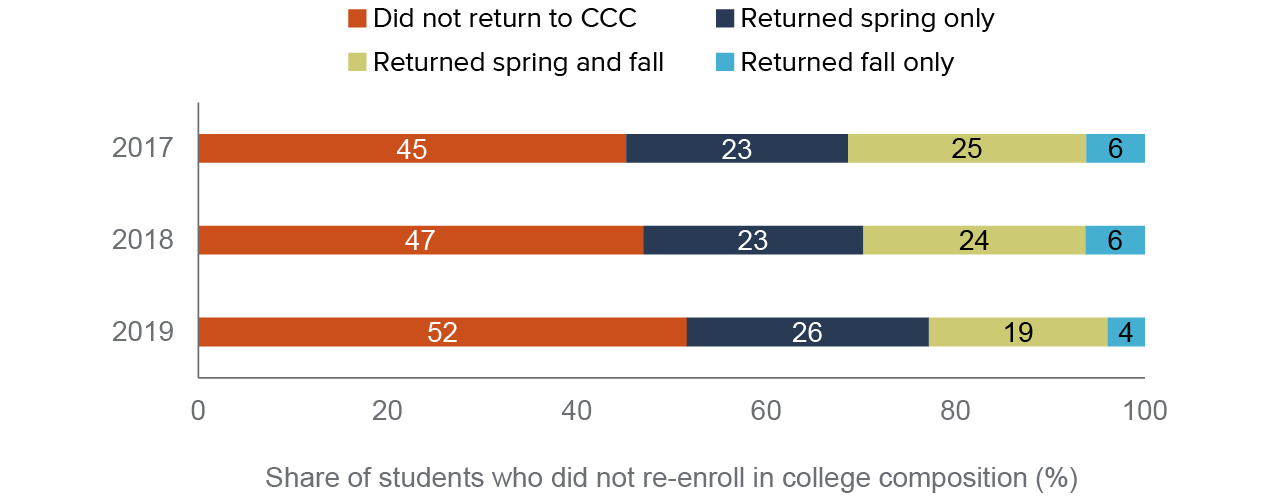
SOURCE: Authors’ calculations using MIS data.
NOTE: First-time English students who did not successfully complete English composition on their first attempt and did not re-enroll as of the following fall. For reference, there were 13,410 students in 2017, 18,943 students in 2018, and 33,764 students in 2019.
Many Who Re-enrolled Did Not Successfully Complete College Composition
Many of those who re-enrolled did not succeed. Conditional on enrollment, only 40 percent of students successfully completed college composition as of the following fall. However, a few colleges had much better results: Ohlone, Coastline, San Mateo, San Diego Miramar, Irvine Valley, Orange Coast, and Marin all had much higher success rates than the systemwide average (Technical Appendix Table B15).
In all, only 16 percent (or 9,256) of the first-time English students in fall 2019 who started in a college composition course and did not succeed in their first attempt reached this important milestone as of fall 2020. Latino and African American students are underrepresented among those who eventually completed college composition.
The evidence accumulated so far shows that, on average, students do better when they start out in college composition. Indeed, 70 percent (or 110,200) of the students who started in a college composition course in fall 2019 successfully completed it as of the following fall. Moving forward, the focus should be on making sure that this promise is realized for all students. The results in this section highlight the need for robust support services to prevent unsuccessful students from falling through the cracks. Colleges must put stronger systems in place to make sure students re-enroll in college composition (such as priority registration or even an automatic opt-in) and provide well-designed corequisite and other targeted supports. Well-designed corequisites embed support within the composition course. In addition to a curriculum/pedagogy that is centered on equity and is culturally relevant, effective corequisites also provide sufficient one-on-one support from instructors and/or embedded tutors and collaborative classroom settings (Cuellar, Rodriguez, and Johnson 2020).
Another important takeaway from this section is that students who are not successful within the new system are struggling with more than academic content, which suggests that more far-reaching and holistic supports are needed. Exit surveys of students and focus groups can help colleges to tailor support to address specific needs.
Student Success beyond College Composition
While AB 705 has led to significant increases in successful completion of college composition, some have expressed concerns that broadening access to transfer-level courses through placement reforms potentially negatively impacts student success beyond these gateway courses. Some have even suggested that the more academically heterogeneous set of students starting in college composition under AB 705 may be leading instructors to “water down” content. In this section, we offer an initial assessment of the effect of placement reforms on outcomes beyond college composition to address these concerns.
Community college students looking to attain a degree or transfer to a four-year university must successfully complete one course in English composition and one course in critical thinking (for which English composition is a prerequisite). Looking at critical thinking course completion is a straightforward approach for this analysis because it builds directly upon the content of college composition.
Examining Critical Thinking Completion Rates
Because we only have data through fall 2020, the fall 2019 cohort is the only post-AB 705-implementation cohort for which we can track students for two additional terms. Unfortunately, this was during the COVID-19 pandemic, so we cannot separate out the effect of AB 705 on subsequent course outcomes. During this time period, critical thinking course completion rates, and all courses for that matter, were negatively impacted by pandemic-driven declines in student’s persistence and success. Indeed, the share of successful college composition students in the fall 2019 cohort who successfully completed a critical thinking course as of fall 2020 was 6 percentage points below the rate observed for the 2018 cohort (57% versus 51%, see Technical Appendix Table B16). It is worth noting that despite the lower share, 6,000 additional students successfully completed this general education requirement.
However, because several colleges were early implementers of placement reforms, we can evaluate the effects of AB 705–type changes in a fall-to-fall window before the pandemic. Specifically, we focus on first-time English students in the 2018 cohort who successfully completed college composition in their first attempt at an early implementer college. We examine the rate at which these students successfully completed a critical thinking course as of fall 2019 and then compare it to the rates among pre–reform cohorts. We look at all critical thinking courses listed in the Intersegmental General Education Transfer Curriculum (IGETC) Area 1B, including courses offered outside English departments.
We use two criteria to flag colleges as early implementers. In our first definition, we include colleges at which at least 80 percent of first-time English students started in college composition in fall 2018, excluding any college with access rates above 70 percent in fall 2017. Nineteen colleges meet this criterion, and these colleges enrolled 32,706 first-time English students in fall 2018—representing 20 percent of all first-time English students in the system. The share of first-time students starting in college composition in this group increased from 55 percent in fall 2017 to 87 percent in fall 2018. Our second criterion includes colleges at which the share of first-time English students increased at least 20 percentage points between fall 2017 and fall 2018—this criterion produces a group that is more closely aligned with the racial makeup of non-implementers. Twenty nine colleges meet this criteria, representing 34 percent of first-time English students in fall 2018. The share of first-time students starting in college composition at these colleges increased from 46 percent in fall 2017 to 79 percent in fall 2018.
In terms of increases in access to college composition, early implementers simulate systemwide changes between fall 2018 and fall 2019, when the share of students starting in college composition increased 27 percentage points. Although access rates to college composition were significantly higher for early implementers than non-implementers in fall 2018, they were below the 95 percent access rate after AB 705 implementation.
Selection bias—which occurs when individuals or groups in a study differ systematically from the population of interest and leads to a systematic error in an association or outcome—is a concern in this type of analysis. However, Figure 12 shows that in fall 2017 (before they changed their placement policies), early implementer colleges are not that different from the rest of the colleges in terms of access to and successful completion of college composition.
Critical Thinking Completion Has Held Steady
While the share of students starting in college composition increased more than 30 percentage points between fall 2017 and fall 2018, we find that the share of students who had successfully completed a critical thinking course a year after completing college composition did not change (Figure 12). This means that the number of students successfully completing a critical thinking course increased significantly—by 33 percent, or 2,217 students, in our first group of early implementers, and by 60 percent, or 5,113 students, in our second group.
Despite significant increases in access to college composition, critical thinking completion rates have not changed much
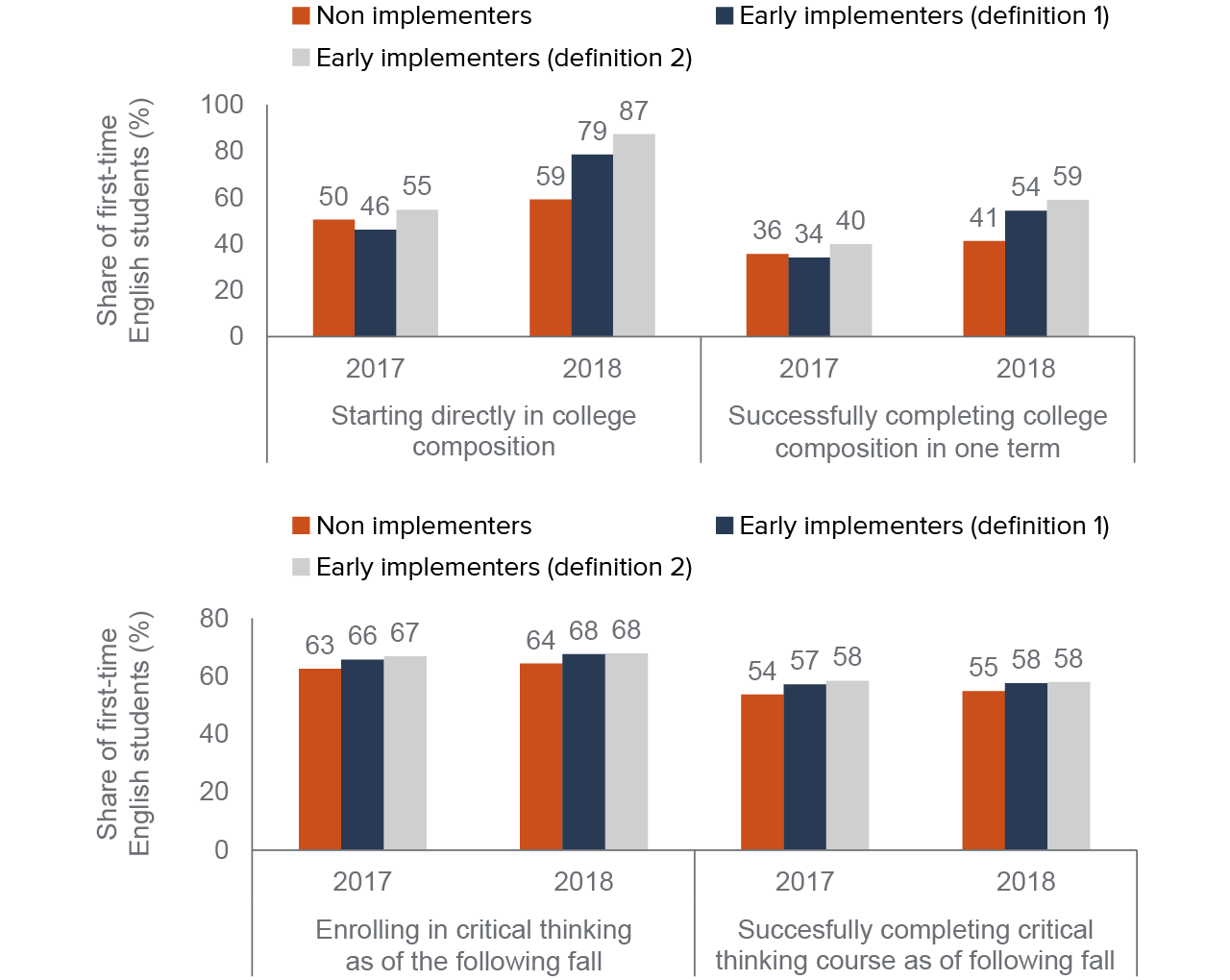
SOURCE: Authors’ calculations using MIS data.
NOTE: Fall cohorts. For the calculation of the share of students successfully completing a critical thinking course as of the next fall we restrict our sample to degree/transfer-intending students. The denominator in the second figure is the number of first-time English students who started in college composition and completed in their first try. See Technical Appendix Table B17 for the regression-adjusted differences in the likelihood of students enrolling and successfully completing a critical thinking course as of the following fall.
These results provide some evidence that broader access does not leave students underprepared to succeed beyond the introductory college composition course. If students were left less prepared, we would expect to see a lower likelihood of passing a critical thinking course among affected cohorts at early-implementer colleges. But this likelihood did not change, suggesting that students are performing just as well along the English course pathway, and thus are as prepared as they were before reform. But now that more students are getting into critical thinking courses thanks to placement reforms, thousands of additional students are one step closer to a degree or transfer.
Have Critical Thinking Outcomes Changed for Corequisite Students?
A related concern about AB 705 reform is that corequisites might not be adequately preparing students to be successful in subsequent courses. Critics of corequisite remediation argue that replacing prerequisite remedial courses with corequisite courses lowers academic standards and weakens students’ foundational knowledge for subsequent courses. For this analysis we follow students enrolled in college composition in fall 2018 through fall 2019. We restrict our analysis to the 43 colleges that offered corequisite sections (either linked support or enhanced courses) in fall 2018. We divide these students into three groups: those enrolled in corequisite models, in standalone college composition courses, and those who took a remedial course before enrolling in college composition.
In fall 2018, the 43 colleges in our analysis enrolled 74,147 students; 54,238 were first-time English students (20% in corequisite models and 80% without support), 15,694 were students previously enrolled in remedial coursework, and 4,215 were continuing students without previous remedial experience (this last group is excluded from our analysis).
Our analysis finds, first, that corequisite students were as likely to complete college composition with a C or better as students who took a remedial course prior (62% in both cases). Second, among those who successfully completed college composition, corequisite students were more likely to enroll in a critical thinking course as of fall 2019 than remedial students (Figure 13). Conditional on enrollment, success rates for those groups are slightly higher than for remedial students. Accounting for both attrition and success, corequisite students outperformed remedial students: 52 percent completed a critical thinking course as of the next fall, compared to 44 percent of remedial students.
Importantly, the comparison group of those who made it through remediation is a subset of motivated students. Corequisite students, on the other hand, are academically heterogeneous and under the old placement system these students would have gone into remediation. Thus, it is even more notable that corequisite students did as well or better in subsequent coursework as the motivated group of remedial students who made it through college composition, and that they did so in a shorter amount of time.
When we compare corequisite and non-support students, we find that corequisite students are as likely to enroll in a critical thinking course as students who started in college composition without support. Their success rates in critical thinking are slightly lower (6 percentage points); that is to be expected, given the likelihood that corequisite students have a wider range of academic preparedness.
Corequisite students are more likely than remedial students to successfully complete a critical thinking course
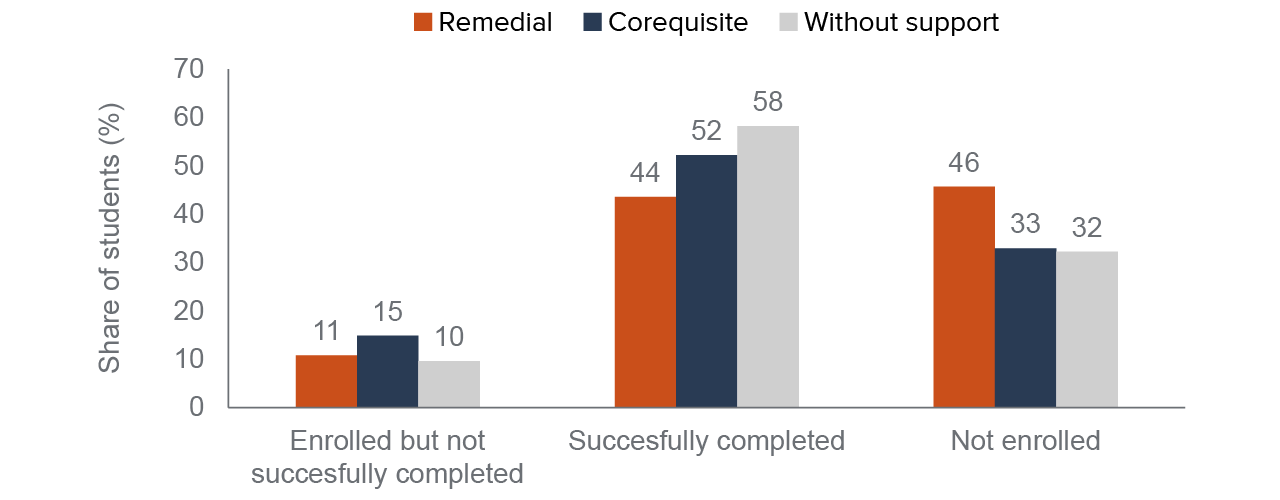
SOURCE: Authors’ calculations using MIS data.
NOTE: Students who successfully completed college composition in fall 2018. Outcome measure as of fall 2019. Only colleges that offered corequisite in fall 2018 are included.
Reducing Racial and Ethnic Gaps in Student Success
In our previous report on placement reform outcomes in math, we asked math department chairs, faculty, and staff to identify key strategies that can address the racial and ethnic gaps in student learning and success that have persisted under AB 705. Unsurprisingly, English department chairs and faculty offered similar insights about closing these gaps, including a consensus that equitable pedagogy, classroom practices, and supports in English classrooms and departments require institutional coordination, communication, and collaboration. In this section, we draw from 15 interviews we conducted with English department chairs and faculty at 14 community colleges experiencing various levels of success in promoting student access, completion, and equity.
Reforming Pedagogy and Classroom Practices
English faculty and department chairs, on average, were fairly optimistic about the implementation of content-based reforms and student-centered classrooms within their departments, citing a heightened willingness or ability to implement more flexible course syllabi, classroom structures, and grading policies. At the same time, department leaders and faculty members highlighted a range of proposed and implemented classroom reforms.
Taking advantage of adaptable course content and structures. English faculty have flexibility to integrate culturally relevant source materials into reading and writing assignments reflecting the lived experiences of their students. Some faculty have integrated concepts such as social justice and bias in their syllabi, while others have adopted thematic course designs that revolve around larger guiding questions aimed at promoting student discourse. At one college in the San Diego region, these strategies may be linked to throughput rates above the state average and equitable rates of completion among Latino students, who account for more than 3 in 4 of all first-time English-takers. As one faculty member at this college put it, English instructors have been encouraged to contextualize the learning experience for students so that “all theory has an application to real world problems,” leading to various thematic course designs including a course theme on prisons and incarceration.
English faculty also said that they benefit from a flexible class structure that allows for a student-centered classroom—one in which students can be co-constructors of knowledge. Additionally, it is natural for English instructors to build upon student opinions, experiences, and points of view to inspire and inform class discussions. Furthermore, English—especially college composition—tends to be more focused on skills than content, allowing for a syllabus that incorporates student input and providing opportunities for students to provide feedback on assessments. Regardless of their strategy of choice, however, most faculty members shared the goal of placing students into positions of power, providing them with more autonomy vis-à-vis reading materials, writing assignments, and grading policies.
Adopting “growth mindsets” in instruction. English faculty and department chairs noted that moving toward more equitable course outcomes requires the elimination of “deficit thinking” and the adoption of “growth mindsets” among instructors. Such mindsets are characterized by an emphasis on confidence-building, affirmative language, and compassionate teaching—which involves offering flexibility to accommodate students’ lived experiences and needs. A growing body of research suggests that productive mindsets among students can be developed by their instructors and are essential to success in community college—they are positively correlated with higher levels of student engagement and performance (Center for Community College Student Engagement 2019).
Several English faculty stressed the need for instructors to incorporate guided variation in their instruction and classroom practices to meet the individual needs of their students. For example, at one college in the Bay Area, where equity gaps have been eliminated between white and Latino students but persist for Black students, many English instructors have participated in a “Teaching for Equity” program, which focuses on the development of anti-racist pedagogy, equitable syllabi, and reformed classroom policies, as well as new ways to equitably engage students with course material. Such faculty have developed essay prompts that engage students with complex real-world ideas and are responsive to diverse experiences, and have created new spaces of expertise for students by incorporating the work of multi-lingual writers.
Experimenting with new approaches to grading. English faculty have implemented larger in-class reforms to grading. Department leaders and faculty members cited research from the California Acceleration Project and from Joe Feldman on “Grading for Equity” as informing their grading philosophy. Similar to what we heard from math faculty, English instructors have attempted to implement less punitive grading policies by reforming the nature of their assessments, accepting more late work, embedding flexibility, and shifting toward a more accurate assessment of student skills. Indeed, more than a third of our interviewees noted that they or their colleagues have experimented with and fully implemented some form of contract-based grading in their classrooms. Such efforts have grown, as research on how contract-based grading can be implemented and its potential positive effects on student success and equity, especially in gateway English classrooms, has increased in recent years (Inoue 2019; Kuhn 2020; Siegal and Gilliland 2021). Others have sought to reward effort and create a more level playing field among students by adopting a “holistic” grading policy that focuses on a students’ comprehensive effort on an assignment, project, or course.
The emphasis on subjectivity and skills has inspired some English instructors to envision a new type of classroom structure. While some have reformed their grading rubrics and created syllabi that allow room for student growth over time, others have attempted to be more thoughtful about how they assess students—in some cases incorporating new non-writing assignments and group projects in an attempt to alternatively assess critical thinking and analytical skills. One faculty member at a college with completion rates among the highest in the state talked about how a core group of faculty in the English department have implemented non-punitive grading strategies, shifting college composition from a high-stakes, assignment-based course to a writing studio in which students are allowed infinite revision opportunities and are encouraged to experiment in their writing. Together, these strategies aim to promote and cultivate success among English students, building on extensive research that suggests that such reforms can create more egalitarian classrooms (Cowan 2020).
Expanding Support for Students and Instructors
Community college faculty and administrators consistently highlight expanded institutional support, in the form of tutoring options, supportive classroom facilities, and professional development for faculty, as crucial in promoting student success and equity under AB 705 (Hern, Henson, and Huntsman 2022). In our interviews, faculty and department leaders at successful colleges stressed the importance of college leaders dedicating resources to support strong and equitable completion now that students have near-universal access to transfer-level coursework. As one English instructor explained, colleges must assume that all of their students encounter persistent struggles and challenges, and thus, must modify their conception of the “traditional student.” In this way, institutional supports are “baked into how [departments] offer, structure, schedule, and matriculate.”
Expanding curricular support options. English faculty and department chairs from both successful and less successful colleges stressed the need for additional resources, in the form of embedded tutors and supplemental instructors, in all classrooms; some saw this as a way to reduce the workloads of primary instructors, and many felt it was important to ensure that each student is provided with adequate one-on-one support. Anecdotal evidence from more than half of the English departments we interviewed suggests that embedded tutoring promotes student success in both corequisite and standalone courses. At one college in the Inland Empire, the English department has embraced the Peer Assistant for Learning (PALs) program as an alternative to the corequisite model, providing weekly support within college composition classrooms. In these classes, student tutors provide in-class support, act as supplemental teaching assistants, holding separate office hours and study sessions outside of class time. Alternatively, other colleges have implemented voluntary non-credit support courses aimed at supporting students in special programs and those needing additional support.
Enhancing academic and student support outside of the classroom. English faculty and department chairs told us that additional academic support for their classes—most notably through writing centers—are needed to further develop individual skills and confidence, supplementing limited classroom time by providing additional one-on-one support and personalized feedback. Library integration is also key for English classes. Several department leaders and instructors emphasized the importance of an embedded and engaged library staff, making students aware of the resources available to them as well as providing research guidance and support. The need for non-academic student supports was also found to be critical to student success and equity. English department leaders were adamant that mental health counseling and support with basic needs, especially in light of the disruptions brought on by the pandemic, are of utmost importance. Within the English context, many also shared the need to expand support for English as a second language (ESL) students, students with learning disabilities (DSPS), and, more broadly, students who are not served by special programs such as Umoja and Puente, and may have limited awareness of, and access to, campus resources.
Notably, almost all department chairs and faculty shared a belief that wraparound supports must be scaled to reach more students. One example of an evidence-based support package is the City University of New York’s Accelerated Study in Associate Programs (ASAP). This initiative, which is aimed at accelerating degree pathways for associate-degree students, addresses the barriers to student success by providing extensive financial support, structured pathways to support academic momentum, and comprehensive direct support services such as personalized advising and tutoring. Since its implementation in 2007, ASAP has proven to be one of CUNY’s most successful initiatives, leading to substantial gains in retention, credit accumulation, progress toward degree, and graduation rates, including for students who started in remediation and among underrepresented students. In California, Skyline College modeled its Promise Scholars Program (PSP) after CUNY’s ASAP, and a 2019–2020 program review suggests that PSP is having positive effects on persistence.
Prioritizing instructor training and support. Support at the instructor-level is equally important. According to the English faculty and department chairs we interviewed, conversations about equity have increased greatly across departments but are mostly in early stages and are highly dependent on faculty initiative. Reforms and training have tended to be decentralized or not fully institutionalized; they are often spearheaded by department faculty, AB 705 workgroups, or community of practice groups organized by instructors.
Some English faculty and department chairs have had some success leading equity conversations and promoting department-level initiatives. At one college with a high level of success and equitable outcomes by race/ethnicity, a year-long training program called Advancing Equity in Teaching Academy (AETA) has proven to be popular among faculty in multiple disciplines, especially those in the English department. At AETA training sessions, faculty discuss how to develop student-friendly syllabi, integrate culturally responsive topics, and bring equity-based grading into their classrooms. Other departments across the state have implemented similar initiatives, using “teach the teacher” models to leverage the experience and insights of faculty members.
One of the most important ways to support faculty training is to provide adequate incentives. Several English department leaders and faculty expressed the need for colleges and departments to provide sufficient monetary compensation for full-time and adjunct faculty, who are highly relied upon in English departments, to attend equity trainings and conferences. A college in the San Diego region with strong outcomes and equity partnered with CSU to offer widely popular faculty practitioner-focused college classes that award university credits and lead to pay raises. Similar innovative approaches to equity-based training will be key to enhancing learning environments and student success in college composition and beyond.
Conclusion
Our research has found that despite the many challenges posed by the COVID-19 pandemic, including the transition to online learning and substantial declines in enrollment, the CCC has continued to provide near-universal access to college composition—such that students of all racial and ethnic groups are now equitably represented in college composition. The system has also sustained significantly higher rates of successful completion of college composition, compared to pre-AB 705—albeit, with rates that are slightly lower post-pandemic. Even with these important gains resulting from the implementation of AB 705, the work is not over. The persistent racial equity gaps in successful course completions and the challenges posed by the pandemic disruptions must be addressed to ensure that all students have an equal opportunity to thrive in college and beyond. To inform ongoing efforts to improve student success and promote more equitable outcomes, we offer the following set of recommendations that are informed by our research.
Identify high-impact curricular support to improve student outcomes and promote equity. The evidence is clear that students who begin in college composition, with or without support, have higher rates of successful completion, on average, than those who begin in remediation. Curricular supports to promote student success could include well-designed, equity-minded corequisite or enhanced courses and embedded tutors or supplemental instruction. It is equally important to provide ongoing equity-centered professional development to faculty to help ensure that curricular supports are implemented effectively. English faculty and department chairs stressed the need to better understand which curricular support models work best for various student groups, taking into account factors such as unit and hour requirements, the distribution of students across sections, and levels of support and resources provided to instructors. A recent report from the Education Trust-West suggests that the state should incentivize expanded implementation of high-impact corequisite courses through an AB 705 implementation budget package focused on equity, leadership, and data on the types of corequisites that are most likely to support student success. The $64 million budget allocation spearheaded by Assemblymember Jacqui Irwin to help community colleges broaden their menu of supports for students enrolled in transfer-level courses is a step in the right direction and will provide much-needed support for a strong and equitable implementation of AB 705.
Enhance supports for students who are not successful under the new system. While there has been a remarkable increase in student success under the new system, a considerable, and growing, share of the student population is not succeeding. Latino and Black students continue to experience gaps in successful course completion compared to their white and Asian peers. We find that students who struggle in college composition tend to be struggling in college more broadly. These findings suggest that colleges need to enhance student support, both in and out of the classroom. Given the complexity of students’ lives and the fact that many are first-time and first-generation college students, embedded institutional supports, college knowledge skills, library skills, and counseling can be especially helpful. It will be important for colleges to provide non-academic support, especially in light of the pandemic, which heightened the need of services to address mental health, food, and housing insecurity. Doing this effectively will require greater coordination between faculty, advisors, counselors, and other support staff. Special programs that provide wraparound support, especially those modeled on effective evidence-based programs like CUNY ASAP, could assist in these efforts.
Prioritize equity-centered instructor training and support. While supporting students is critical to improving outcomes, faculty support is equally important. Moving forward, it will be important to provide opportunities for faculty to come together to learn about new evidence-based strategies and share strategies for improving equitable outcomes in the classroom. These opportunities might include training that can help instructors shift from “deficit thinking” to “growth mindsets.” In our interviews, we learned that one English department with particularly strong equity outcomes supports equitable teaching and learning by training its faculty to use student-centered Puente and Umoja principles, which place an emphasis on student strengths and backgrounds. This department incentivizes faculty participation in equity-centered professional development by offering California State University credits that help faculty move up the pay scale. Given the academic impact of the challenges students face outside of the classroom, training on how to conduct needs assessments is also important. For example, one English faculty noted that connecting with students early in the semester makes it easier to refer them to effective resources and supports. Moving forward, ongoing and expanded support for equity-centered teaching and professional development opportunities, especially for faculty teaching corequisites, will be key to narrowing racial equity gaps.
Continue to monitor racial equity implications of offering remedial courses. While only a small share of first-time English students enroll in remediation systemwide, we find that Black students are more likely to enroll in these courses—which are highly correlated with lower levels of success in completing college composition. Enrollment in these courses should be monitored to promote equitable student outcomes. In our interviews, we found that one college continued to offer remediation primarily for English Learners and students with disabilities—but their institutional research data revealed that Black students were also more likely to enroll. In response to their analysis of the data, the college reduced their remedial course offerings, and faculty and counselors began doing more to encourage Black students to begin in college composition. We found that at this college, Latino and Black students are among the most equitably represented groups in successful course completion. As this work continues, it will be imperative that race and ethnicity no longer be a determinant of remedial course enrollments and outcomes.
Build on strategies that helped mitigate the effects of the pandemic and adapt them for a face-to-face environment. The pandemic highlighted the ways online learning can support student success. Our interviews with English faculty and department leaders revealed that the transition to online learning helped expand and enhance online office hours, tutoring, writing centers, counseling, and mental health services. Putting these services and supports online made the referral process easier, as they were able to include some of the information and links in course modules and syllabi. Additionally, access to these services outside traditional business hours benefited students with family or work responsibilities. During the pandemic, some faculty also told us that they experimented with flexible grading and assessment practices that helped support student success—including accepting late work or adopting contract grading. Finally, the expansion of food pantries and mental health services during the pandemic helped solidify the understanding that student success is dependent not just on reading, writing or math skills, but the wellbeing of the whole student. As courses resume mostly face-to-face, it will be important to ensure that flexibility and online support continue to support more equitable outcomes.
Despite the remarkable progress under AB 705, more work is needed to reduce persistent racial equity gaps that remain in successful completion of college composition. At the same time, large declines in first-time English enrollment and a small decline in student success in the fall 2020 term suggest that continued reforms will be necessary to address possible long-term effects of the pandemic. Our research provides direction that could inform ongoing efforts that aim to improve student success and promote more equitable outcomes.
Topics
Access Completion Equity Higher Education



